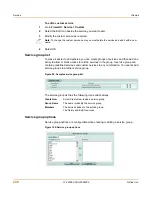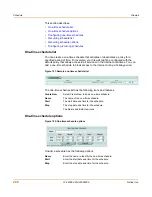
Firewall
Virtual IP
FortiGate-5000 series Administration Guide
01-28008-0013-20050204
227
Virtual IP has the following options.
Configuring virtual IPs
To add a static NAT virtual IP
1
Go to
Firewall > Virtual IP
.
2
Select Create New.
3
Enter a name for the virtual IP.
4
Select the virtual IP External Interface from the list.
The external interface is connected to the source network and receives the packets to
be forwarded to the destination network. You can select any firewall interface or a
VLAN subinterface. You can set the virtual IP external interface to any FortiGate
interface.
Table 25 on page 228
contains example virtual IP external interface settings
and describes the policies to which you can add the resulting virtual IP.
5
Select Static NAT.
6
Enter the External IP Address that you want to map to an address on the destination
network.
For example, if the virtual IP provides access from the Internet to a web server on a
destination network, the external IP address must be a static IP address obtained from
your ISP for your web server. This address must be a unique address that is not used
by another host and cannot be the same as the IP address of the external interface
selected in step
4
. However, the external IP address must be routed to the selected
interface. The virtual IP address and the external IP address can be on different
subnets.
7
Enter the Map to IP address to which to map the external IP address. For example,
the IP address of a web server on an internal network.
8
Select OK.
You can now add the virtual IP to firewall policies.
Name
Enter the name to identify the virtual IP. Addresses, address groups, and
virtual IPs must all have unique names to avoid confusion in firewall
policies.
External Interface
Select the virtual IP external interface from the list.
Type
Select Static NAT or Port Forwarding.
External IP
Address
Enter the external IP address that you want to map to an address on the
destination network. To configure dynamic port forwarding, set the external
IP address to 0.0.0.0.
External Service
Port
Enter the external service port number that you want to configure port
forwarding for. (Port forwarding only.)
Map to IP
Enter the real IP address on the destination network.
Map to Port
Enter the port number to be added to packets when they are forwarded.
(Port forwarding only.)
Protocol
Select the protocol (TCP or UDP) that you want the forwarded packets to
use. (Port forwarding only.)
Note:
The firewall translates the source address of outbound packets from the host with the
Map to IP address to the virtual IP External IP Address, instead of the firewall external address.
Summary of Contents for FortiGate FortiGate-5020
Page 86: ...86 01 28008 0013 20050204 Fortinet Inc Dynamic IP System DHCP ...
Page 118: ...118 01 28008 0013 20050204 Fortinet Inc FortiManager System Config ...
Page 254: ...254 01 28008 0013 20050204 Fortinet Inc CLI configuration User ...
Page 318: ...318 01 28008 0013 20050204 Fortinet Inc CLI configuration Antivirus ...
Page 350: ...350 01 28008 0013 20050204 Fortinet Inc Using Perl regular expressions Spam filter ...
Page 370: ...370 01 28008 0013 20050204 Fortinet Inc CLI configuration Log Report ...
Page 382: ...382 01 28008 0013 20050204 Fortinet Inc Glossary ...
Page 402: ...402 01 28008 0013 20050204 Fortinet Inc Index ...








































